University Business Research Report: Employee Motivation
VerifiedAdded on 2020/03/04
|17
|3745
|42
Report
AI Summary
This business research report provides a comprehensive literature review on the relationship between organizational culture, employee motivation, and performance, focusing on the context of Australian supermarkets. The report explores how organizational culture influences employee motivation and its subsequent impact on employee performance and productivity. It discusses various motivational theories, including Maslow's hierarchy of needs, Herzberg's two-factor theory, and expectancy theory, and their application in the workplace. The study examines the positive and negative impacts of these theories on employee performance. Furthermore, it investigates the impact of organizational culture on employee performance and motivation and the factors that contribute to a robust organizational culture. The research also includes several research questions related to the impact of culture on employee motivation and performance, as well as a questionnaire survey to gather data on the topic.
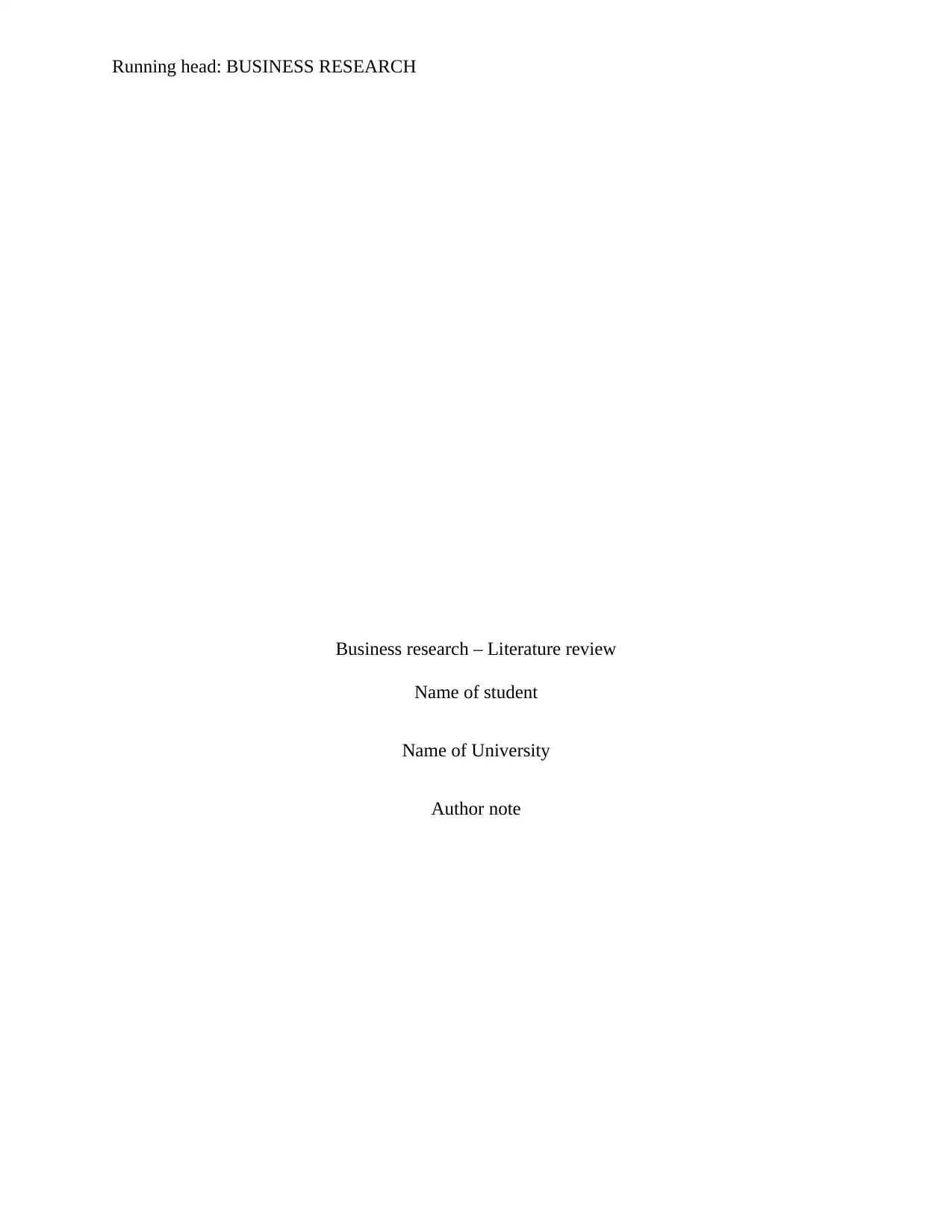
Running head: BUSINESS RESEARCH
Business research – Literature review
Name of student
Name of University
Author note
Business research – Literature review
Name of student
Name of University
Author note
Secure Best Marks with AI Grader
Need help grading? Try our AI Grader for instant feedback on your assignments.
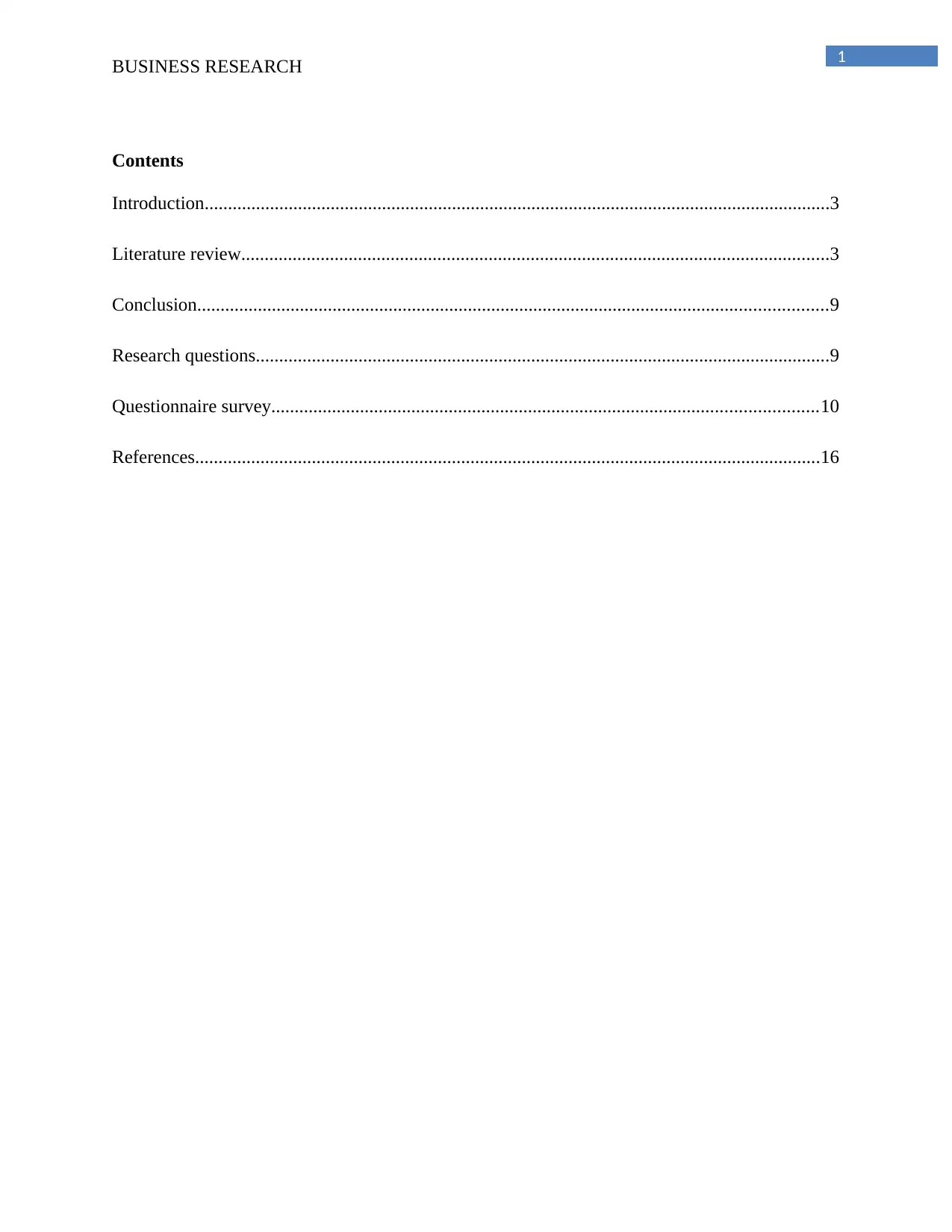
1
BUSINESS RESEARCH
Contents
Introduction......................................................................................................................................3
Literature review..............................................................................................................................3
Conclusion.......................................................................................................................................9
Research questions...........................................................................................................................9
Questionnaire survey.....................................................................................................................10
References......................................................................................................................................16
BUSINESS RESEARCH
Contents
Introduction......................................................................................................................................3
Literature review..............................................................................................................................3
Conclusion.......................................................................................................................................9
Research questions...........................................................................................................................9
Questionnaire survey.....................................................................................................................10
References......................................................................................................................................16
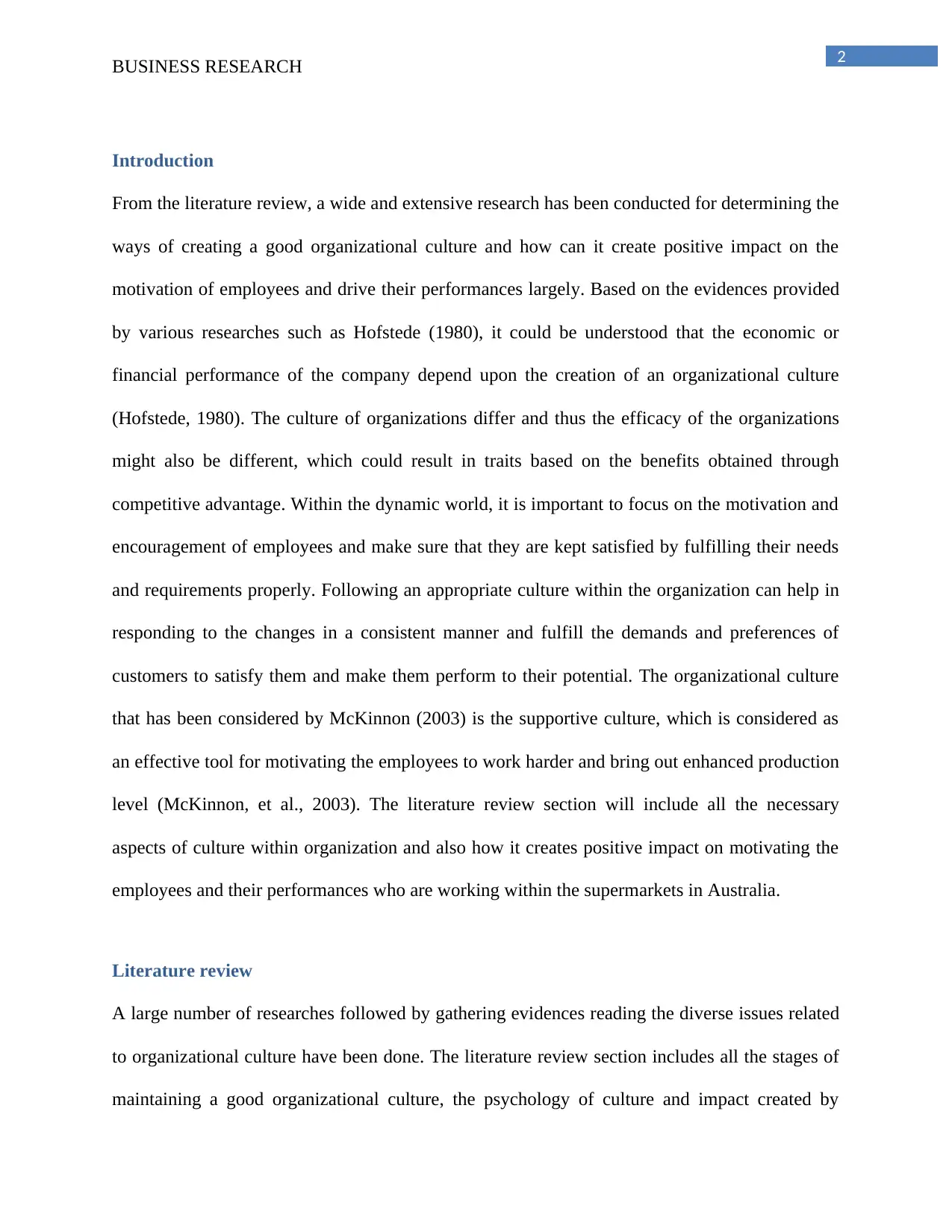
2
BUSINESS RESEARCH
Introduction
From the literature review, a wide and extensive research has been conducted for determining the
ways of creating a good organizational culture and how can it create positive impact on the
motivation of employees and drive their performances largely. Based on the evidences provided
by various researches such as Hofstede (1980), it could be understood that the economic or
financial performance of the company depend upon the creation of an organizational culture
(Hofstede, 1980). The culture of organizations differ and thus the efficacy of the organizations
might also be different, which could result in traits based on the benefits obtained through
competitive advantage. Within the dynamic world, it is important to focus on the motivation and
encouragement of employees and make sure that they are kept satisfied by fulfilling their needs
and requirements properly. Following an appropriate culture within the organization can help in
responding to the changes in a consistent manner and fulfill the demands and preferences of
customers to satisfy them and make them perform to their potential. The organizational culture
that has been considered by McKinnon (2003) is the supportive culture, which is considered as
an effective tool for motivating the employees to work harder and bring out enhanced production
level (McKinnon, et al., 2003). The literature review section will include all the necessary
aspects of culture within organization and also how it creates positive impact on motivating the
employees and their performances who are working within the supermarkets in Australia.
Literature review
A large number of researches followed by gathering evidences reading the diverse issues related
to organizational culture have been done. The literature review section includes all the stages of
maintaining a good organizational culture, the psychology of culture and impact created by
BUSINESS RESEARCH
Introduction
From the literature review, a wide and extensive research has been conducted for determining the
ways of creating a good organizational culture and how can it create positive impact on the
motivation of employees and drive their performances largely. Based on the evidences provided
by various researches such as Hofstede (1980), it could be understood that the economic or
financial performance of the company depend upon the creation of an organizational culture
(Hofstede, 1980). The culture of organizations differ and thus the efficacy of the organizations
might also be different, which could result in traits based on the benefits obtained through
competitive advantage. Within the dynamic world, it is important to focus on the motivation and
encouragement of employees and make sure that they are kept satisfied by fulfilling their needs
and requirements properly. Following an appropriate culture within the organization can help in
responding to the changes in a consistent manner and fulfill the demands and preferences of
customers to satisfy them and make them perform to their potential. The organizational culture
that has been considered by McKinnon (2003) is the supportive culture, which is considered as
an effective tool for motivating the employees to work harder and bring out enhanced production
level (McKinnon, et al., 2003). The literature review section will include all the necessary
aspects of culture within organization and also how it creates positive impact on motivating the
employees and their performances who are working within the supermarkets in Australia.
Literature review
A large number of researches followed by gathering evidences reading the diverse issues related
to organizational culture have been done. The literature review section includes all the stages of
maintaining a good organizational culture, the psychology of culture and impact created by
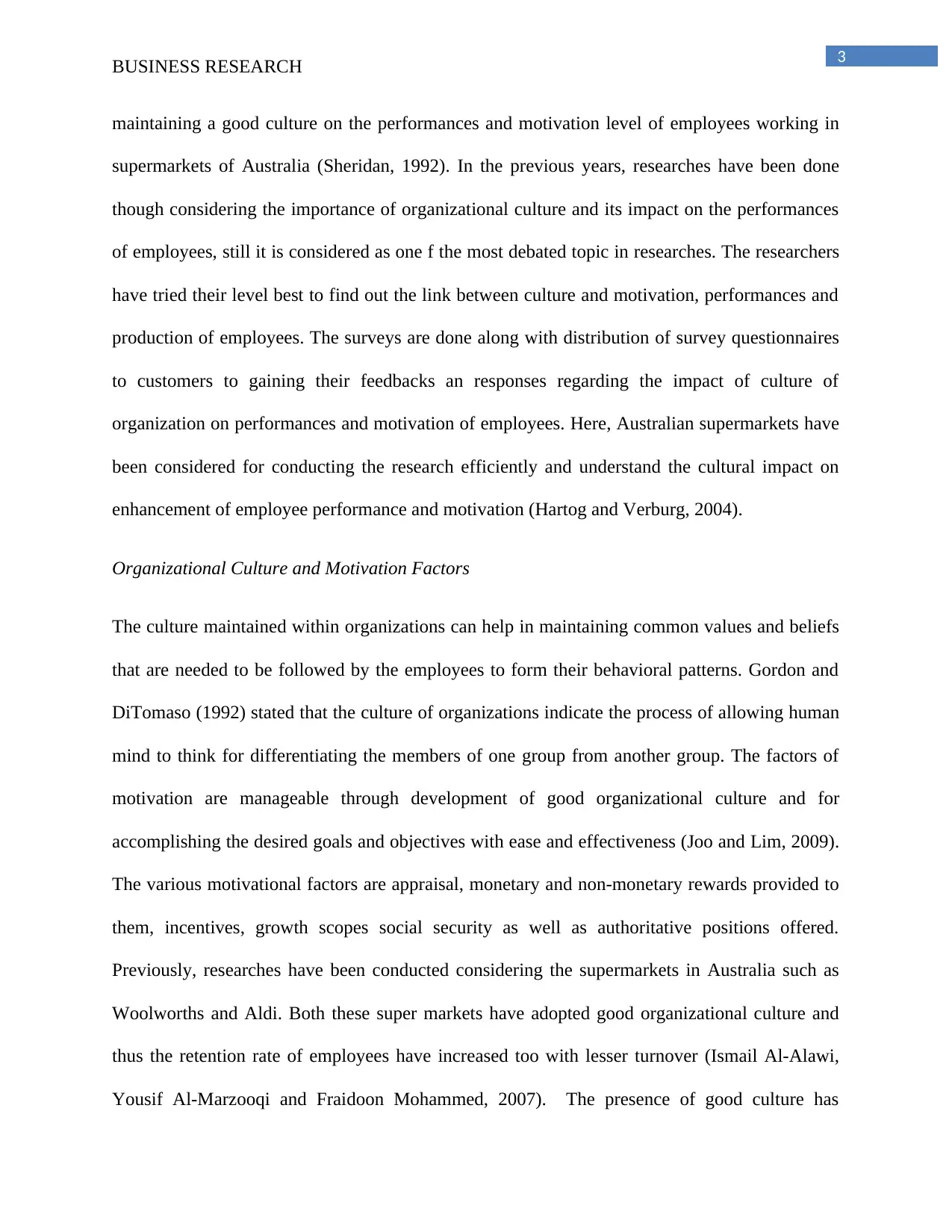
3
BUSINESS RESEARCH
maintaining a good culture on the performances and motivation level of employees working in
supermarkets of Australia (Sheridan, 1992). In the previous years, researches have been done
though considering the importance of organizational culture and its impact on the performances
of employees, still it is considered as one f the most debated topic in researches. The researchers
have tried their level best to find out the link between culture and motivation, performances and
production of employees. The surveys are done along with distribution of survey questionnaires
to customers to gaining their feedbacks an responses regarding the impact of culture of
organization on performances and motivation of employees. Here, Australian supermarkets have
been considered for conducting the research efficiently and understand the cultural impact on
enhancement of employee performance and motivation (Hartog and Verburg, 2004).
Organizational Culture and Motivation Factors
The culture maintained within organizations can help in maintaining common values and beliefs
that are needed to be followed by the employees to form their behavioral patterns. Gordon and
DiTomaso (1992) stated that the culture of organizations indicate the process of allowing human
mind to think for differentiating the members of one group from another group. The factors of
motivation are manageable through development of good organizational culture and for
accomplishing the desired goals and objectives with ease and effectiveness (Joo and Lim, 2009).
The various motivational factors are appraisal, monetary and non-monetary rewards provided to
them, incentives, growth scopes social security as well as authoritative positions offered.
Previously, researches have been conducted considering the supermarkets in Australia such as
Woolworths and Aldi. Both these super markets have adopted good organizational culture and
thus the retention rate of employees have increased too with lesser turnover (Ismail Al-Alawi,
Yousif Al-Marzooqi and Fraidoon Mohammed, 2007). The presence of good culture has
BUSINESS RESEARCH
maintaining a good culture on the performances and motivation level of employees working in
supermarkets of Australia (Sheridan, 1992). In the previous years, researches have been done
though considering the importance of organizational culture and its impact on the performances
of employees, still it is considered as one f the most debated topic in researches. The researchers
have tried their level best to find out the link between culture and motivation, performances and
production of employees. The surveys are done along with distribution of survey questionnaires
to customers to gaining their feedbacks an responses regarding the impact of culture of
organization on performances and motivation of employees. Here, Australian supermarkets have
been considered for conducting the research efficiently and understand the cultural impact on
enhancement of employee performance and motivation (Hartog and Verburg, 2004).
Organizational Culture and Motivation Factors
The culture maintained within organizations can help in maintaining common values and beliefs
that are needed to be followed by the employees to form their behavioral patterns. Gordon and
DiTomaso (1992) stated that the culture of organizations indicate the process of allowing human
mind to think for differentiating the members of one group from another group. The factors of
motivation are manageable through development of good organizational culture and for
accomplishing the desired goals and objectives with ease and effectiveness (Joo and Lim, 2009).
The various motivational factors are appraisal, monetary and non-monetary rewards provided to
them, incentives, growth scopes social security as well as authoritative positions offered.
Previously, researches have been conducted considering the supermarkets in Australia such as
Woolworths and Aldi. Both these super markets have adopted good organizational culture and
thus the retention rate of employees have increased too with lesser turnover (Ismail Al-Alawi,
Yousif Al-Marzooqi and Fraidoon Mohammed, 2007). The presence of good culture has
Secure Best Marks with AI Grader
Need help grading? Try our AI Grader for instant feedback on your assignments.
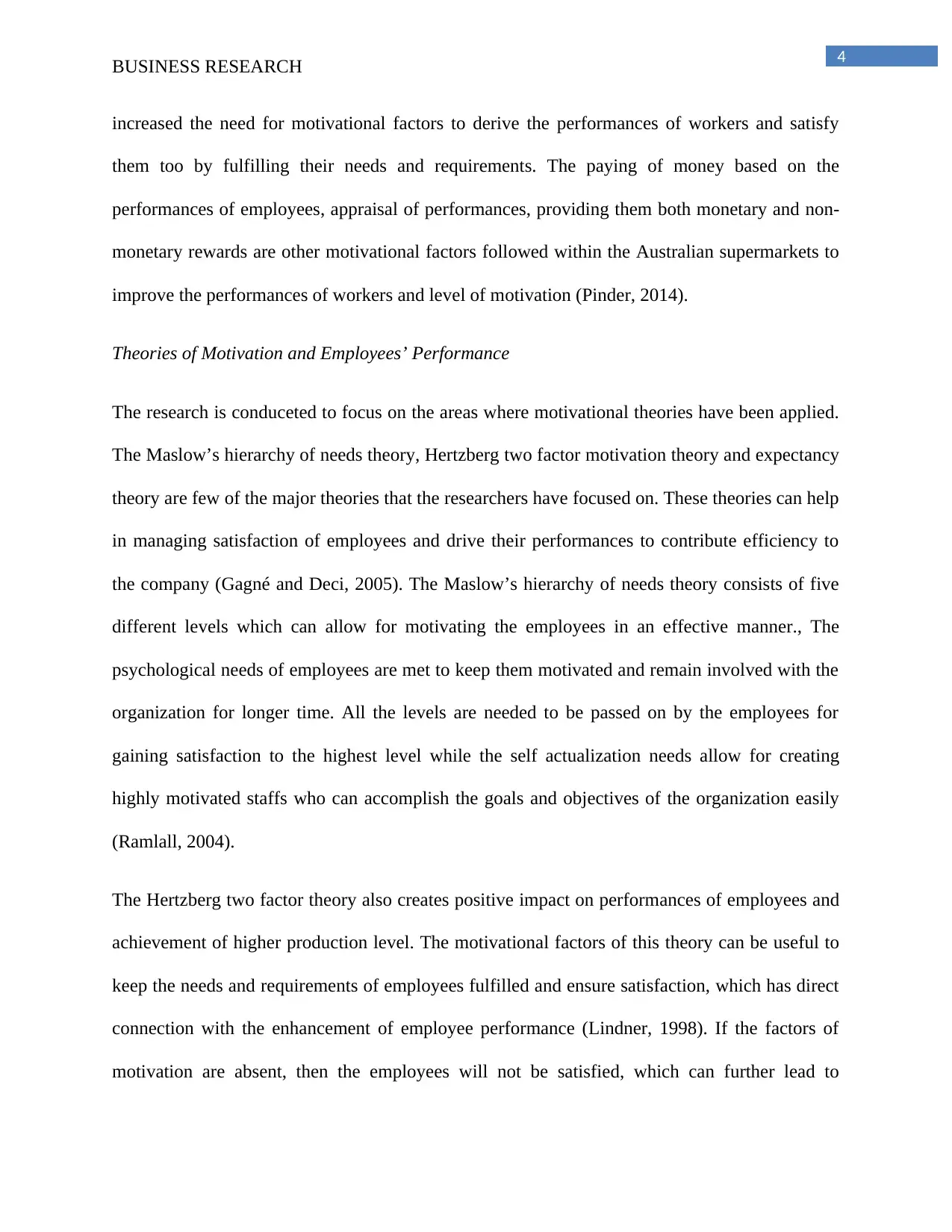
4
BUSINESS RESEARCH
increased the need for motivational factors to derive the performances of workers and satisfy
them too by fulfilling their needs and requirements. The paying of money based on the
performances of employees, appraisal of performances, providing them both monetary and non-
monetary rewards are other motivational factors followed within the Australian supermarkets to
improve the performances of workers and level of motivation (Pinder, 2014).
Theories of Motivation and Employees’ Performance
The research is conduceted to focus on the areas where motivational theories have been applied.
The Maslow’s hierarchy of needs theory, Hertzberg two factor motivation theory and expectancy
theory are few of the major theories that the researchers have focused on. These theories can help
in managing satisfaction of employees and drive their performances to contribute efficiency to
the company (Gagné and Deci, 2005). The Maslow’s hierarchy of needs theory consists of five
different levels which can allow for motivating the employees in an effective manner., The
psychological needs of employees are met to keep them motivated and remain involved with the
organization for longer time. All the levels are needed to be passed on by the employees for
gaining satisfaction to the highest level while the self actualization needs allow for creating
highly motivated staffs who can accomplish the goals and objectives of the organization easily
(Ramlall, 2004).
The Hertzberg two factor theory also creates positive impact on performances of employees and
achievement of higher production level. The motivational factors of this theory can be useful to
keep the needs and requirements of employees fulfilled and ensure satisfaction, which has direct
connection with the enhancement of employee performance (Lindner, 1998). If the factors of
motivation are absent, then the employees will not be satisfied, which can further lead to
BUSINESS RESEARCH
increased the need for motivational factors to derive the performances of workers and satisfy
them too by fulfilling their needs and requirements. The paying of money based on the
performances of employees, appraisal of performances, providing them both monetary and non-
monetary rewards are other motivational factors followed within the Australian supermarkets to
improve the performances of workers and level of motivation (Pinder, 2014).
Theories of Motivation and Employees’ Performance
The research is conduceted to focus on the areas where motivational theories have been applied.
The Maslow’s hierarchy of needs theory, Hertzberg two factor motivation theory and expectancy
theory are few of the major theories that the researchers have focused on. These theories can help
in managing satisfaction of employees and drive their performances to contribute efficiency to
the company (Gagné and Deci, 2005). The Maslow’s hierarchy of needs theory consists of five
different levels which can allow for motivating the employees in an effective manner., The
psychological needs of employees are met to keep them motivated and remain involved with the
organization for longer time. All the levels are needed to be passed on by the employees for
gaining satisfaction to the highest level while the self actualization needs allow for creating
highly motivated staffs who can accomplish the goals and objectives of the organization easily
(Ramlall, 2004).
The Hertzberg two factor theory also creates positive impact on performances of employees and
achievement of higher production level. The motivational factors of this theory can be useful to
keep the needs and requirements of employees fulfilled and ensure satisfaction, which has direct
connection with the enhancement of employee performance (Lindner, 1998). If the factors of
motivation are absent, then the employees will not be satisfied, which can further lead to
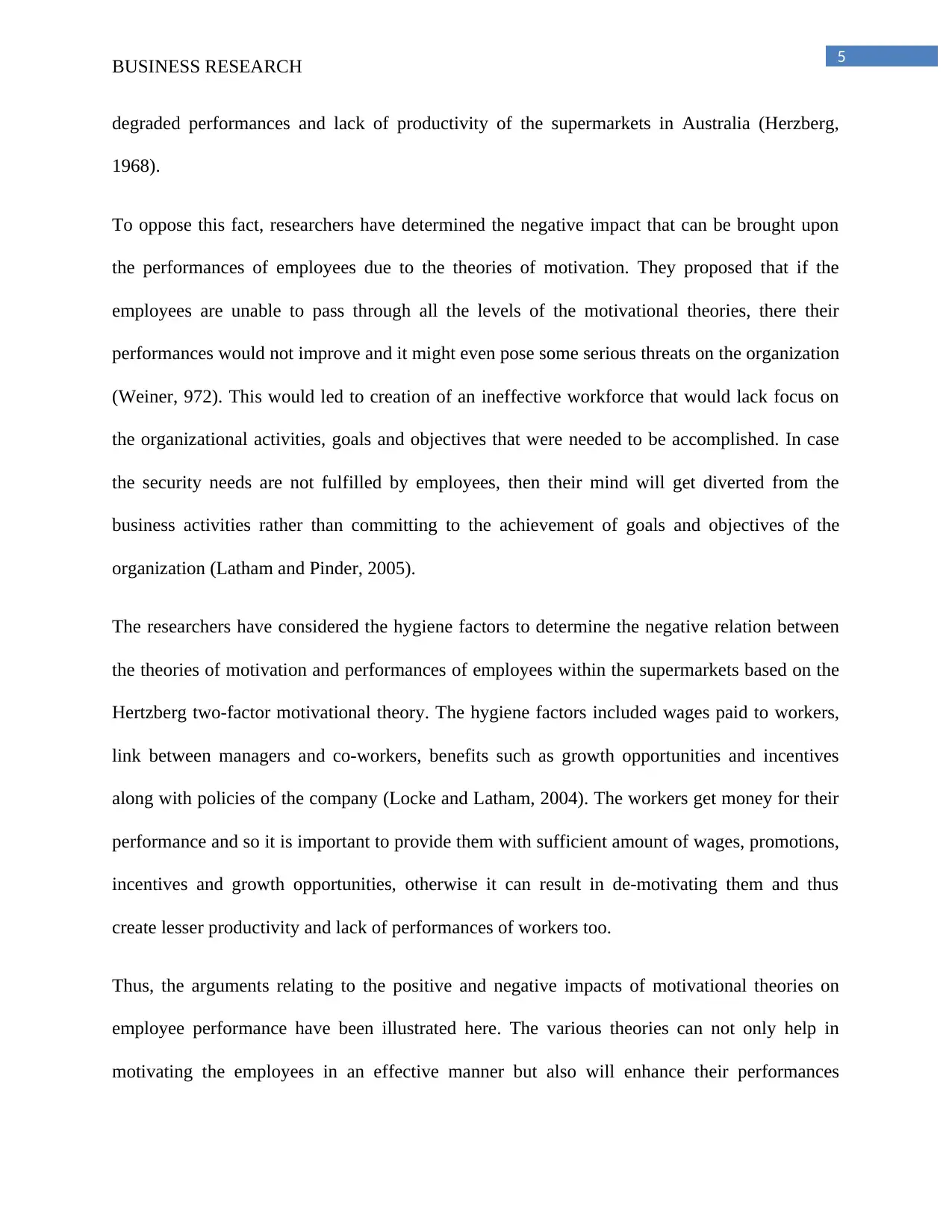
5
BUSINESS RESEARCH
degraded performances and lack of productivity of the supermarkets in Australia (Herzberg,
1968).
To oppose this fact, researchers have determined the negative impact that can be brought upon
the performances of employees due to the theories of motivation. They proposed that if the
employees are unable to pass through all the levels of the motivational theories, there their
performances would not improve and it might even pose some serious threats on the organization
(Weiner, 972). This would led to creation of an ineffective workforce that would lack focus on
the organizational activities, goals and objectives that were needed to be accomplished. In case
the security needs are not fulfilled by employees, then their mind will get diverted from the
business activities rather than committing to the achievement of goals and objectives of the
organization (Latham and Pinder, 2005).
The researchers have considered the hygiene factors to determine the negative relation between
the theories of motivation and performances of employees within the supermarkets based on the
Hertzberg two-factor motivational theory. The hygiene factors included wages paid to workers,
link between managers and co-workers, benefits such as growth opportunities and incentives
along with policies of the company (Locke and Latham, 2004). The workers get money for their
performance and so it is important to provide them with sufficient amount of wages, promotions,
incentives and growth opportunities, otherwise it can result in de-motivating them and thus
create lesser productivity and lack of performances of workers too.
Thus, the arguments relating to the positive and negative impacts of motivational theories on
employee performance have been illustrated here. The various theories can not only help in
motivating the employees in an effective manner but also will enhance their performances
BUSINESS RESEARCH
degraded performances and lack of productivity of the supermarkets in Australia (Herzberg,
1968).
To oppose this fact, researchers have determined the negative impact that can be brought upon
the performances of employees due to the theories of motivation. They proposed that if the
employees are unable to pass through all the levels of the motivational theories, there their
performances would not improve and it might even pose some serious threats on the organization
(Weiner, 972). This would led to creation of an ineffective workforce that would lack focus on
the organizational activities, goals and objectives that were needed to be accomplished. In case
the security needs are not fulfilled by employees, then their mind will get diverted from the
business activities rather than committing to the achievement of goals and objectives of the
organization (Latham and Pinder, 2005).
The researchers have considered the hygiene factors to determine the negative relation between
the theories of motivation and performances of employees within the supermarkets based on the
Hertzberg two-factor motivational theory. The hygiene factors included wages paid to workers,
link between managers and co-workers, benefits such as growth opportunities and incentives
along with policies of the company (Locke and Latham, 2004). The workers get money for their
performance and so it is important to provide them with sufficient amount of wages, promotions,
incentives and growth opportunities, otherwise it can result in de-motivating them and thus
create lesser productivity and lack of performances of workers too.
Thus, the arguments relating to the positive and negative impacts of motivational theories on
employee performance have been illustrated here. The various theories can not only help in
motivating the employees in an effective manner but also will enhance their performances
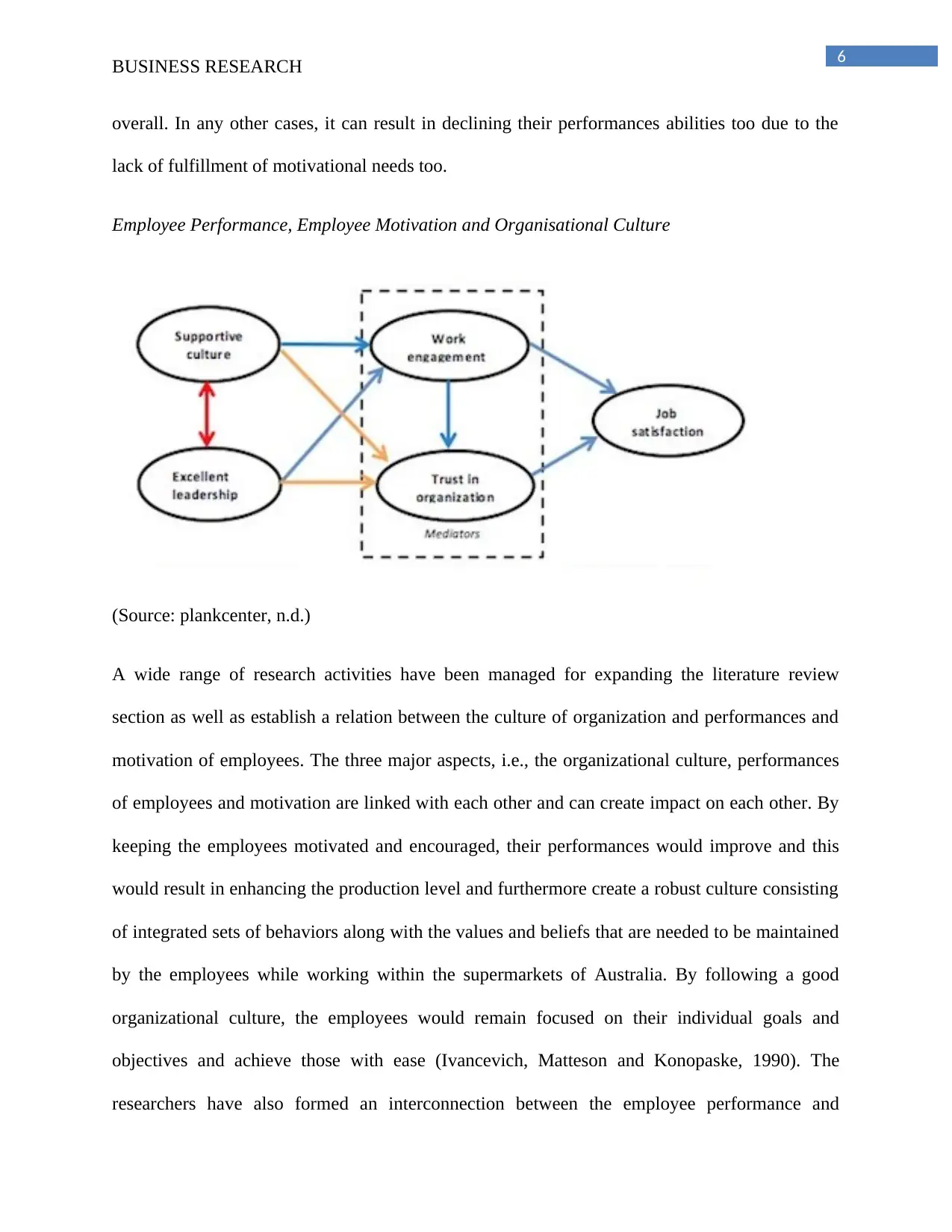
6
BUSINESS RESEARCH
overall. In any other cases, it can result in declining their performances abilities too due to the
lack of fulfillment of motivational needs too.
Employee Performance, Employee Motivation and Organisational Culture
(Source: plankcenter, n.d.)
A wide range of research activities have been managed for expanding the literature review
section as well as establish a relation between the culture of organization and performances and
motivation of employees. The three major aspects, i.e., the organizational culture, performances
of employees and motivation are linked with each other and can create impact on each other. By
keeping the employees motivated and encouraged, their performances would improve and this
would result in enhancing the production level and furthermore create a robust culture consisting
of integrated sets of behaviors along with the values and beliefs that are needed to be maintained
by the employees while working within the supermarkets of Australia. By following a good
organizational culture, the employees would remain focused on their individual goals and
objectives and achieve those with ease (Ivancevich, Matteson and Konopaske, 1990). The
researchers have also formed an interconnection between the employee performance and
BUSINESS RESEARCH
overall. In any other cases, it can result in declining their performances abilities too due to the
lack of fulfillment of motivational needs too.
Employee Performance, Employee Motivation and Organisational Culture
(Source: plankcenter, n.d.)
A wide range of research activities have been managed for expanding the literature review
section as well as establish a relation between the culture of organization and performances and
motivation of employees. The three major aspects, i.e., the organizational culture, performances
of employees and motivation are linked with each other and can create impact on each other. By
keeping the employees motivated and encouraged, their performances would improve and this
would result in enhancing the production level and furthermore create a robust culture consisting
of integrated sets of behaviors along with the values and beliefs that are needed to be maintained
by the employees while working within the supermarkets of Australia. By following a good
organizational culture, the employees would remain focused on their individual goals and
objectives and achieve those with ease (Ivancevich, Matteson and Konopaske, 1990). The
researchers have also formed an interconnection between the employee performance and
Paraphrase This Document
Need a fresh take? Get an instant paraphrase of this document with our AI Paraphraser
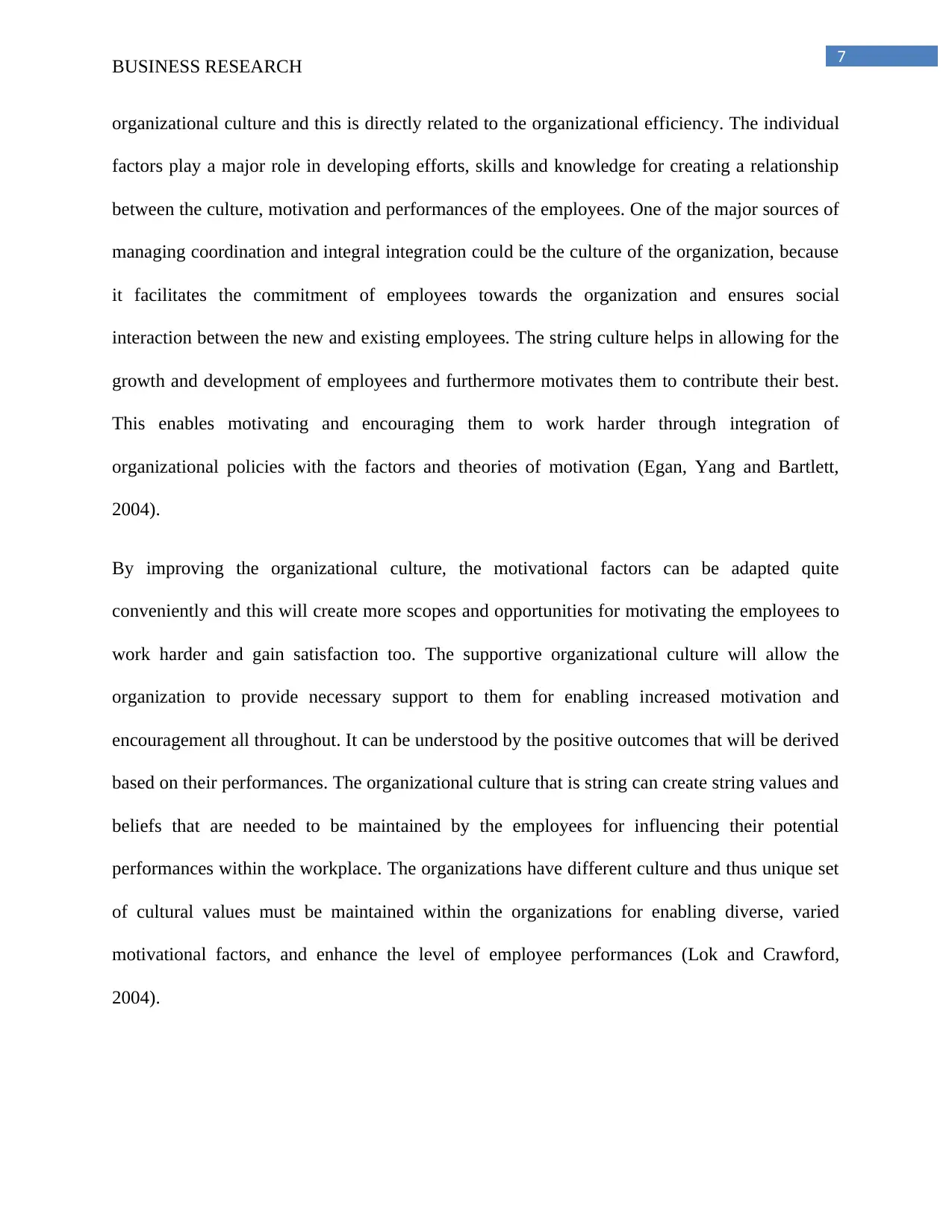
7
BUSINESS RESEARCH
organizational culture and this is directly related to the organizational efficiency. The individual
factors play a major role in developing efforts, skills and knowledge for creating a relationship
between the culture, motivation and performances of the employees. One of the major sources of
managing coordination and integral integration could be the culture of the organization, because
it facilitates the commitment of employees towards the organization and ensures social
interaction between the new and existing employees. The string culture helps in allowing for the
growth and development of employees and furthermore motivates them to contribute their best.
This enables motivating and encouraging them to work harder through integration of
organizational policies with the factors and theories of motivation (Egan, Yang and Bartlett,
2004).
By improving the organizational culture, the motivational factors can be adapted quite
conveniently and this will create more scopes and opportunities for motivating the employees to
work harder and gain satisfaction too. The supportive organizational culture will allow the
organization to provide necessary support to them for enabling increased motivation and
encouragement all throughout. It can be understood by the positive outcomes that will be derived
based on their performances. The organizational culture that is string can create string values and
beliefs that are needed to be maintained by the employees for influencing their potential
performances within the workplace. The organizations have different culture and thus unique set
of cultural values must be maintained within the organizations for enabling diverse, varied
motivational factors, and enhance the level of employee performances (Lok and Crawford,
2004).
BUSINESS RESEARCH
organizational culture and this is directly related to the organizational efficiency. The individual
factors play a major role in developing efforts, skills and knowledge for creating a relationship
between the culture, motivation and performances of the employees. One of the major sources of
managing coordination and integral integration could be the culture of the organization, because
it facilitates the commitment of employees towards the organization and ensures social
interaction between the new and existing employees. The string culture helps in allowing for the
growth and development of employees and furthermore motivates them to contribute their best.
This enables motivating and encouraging them to work harder through integration of
organizational policies with the factors and theories of motivation (Egan, Yang and Bartlett,
2004).
By improving the organizational culture, the motivational factors can be adapted quite
conveniently and this will create more scopes and opportunities for motivating the employees to
work harder and gain satisfaction too. The supportive organizational culture will allow the
organization to provide necessary support to them for enabling increased motivation and
encouragement all throughout. It can be understood by the positive outcomes that will be derived
based on their performances. The organizational culture that is string can create string values and
beliefs that are needed to be maintained by the employees for influencing their potential
performances within the workplace. The organizations have different culture and thus unique set
of cultural values must be maintained within the organizations for enabling diverse, varied
motivational factors, and enhance the level of employee performances (Lok and Crawford,
2004).
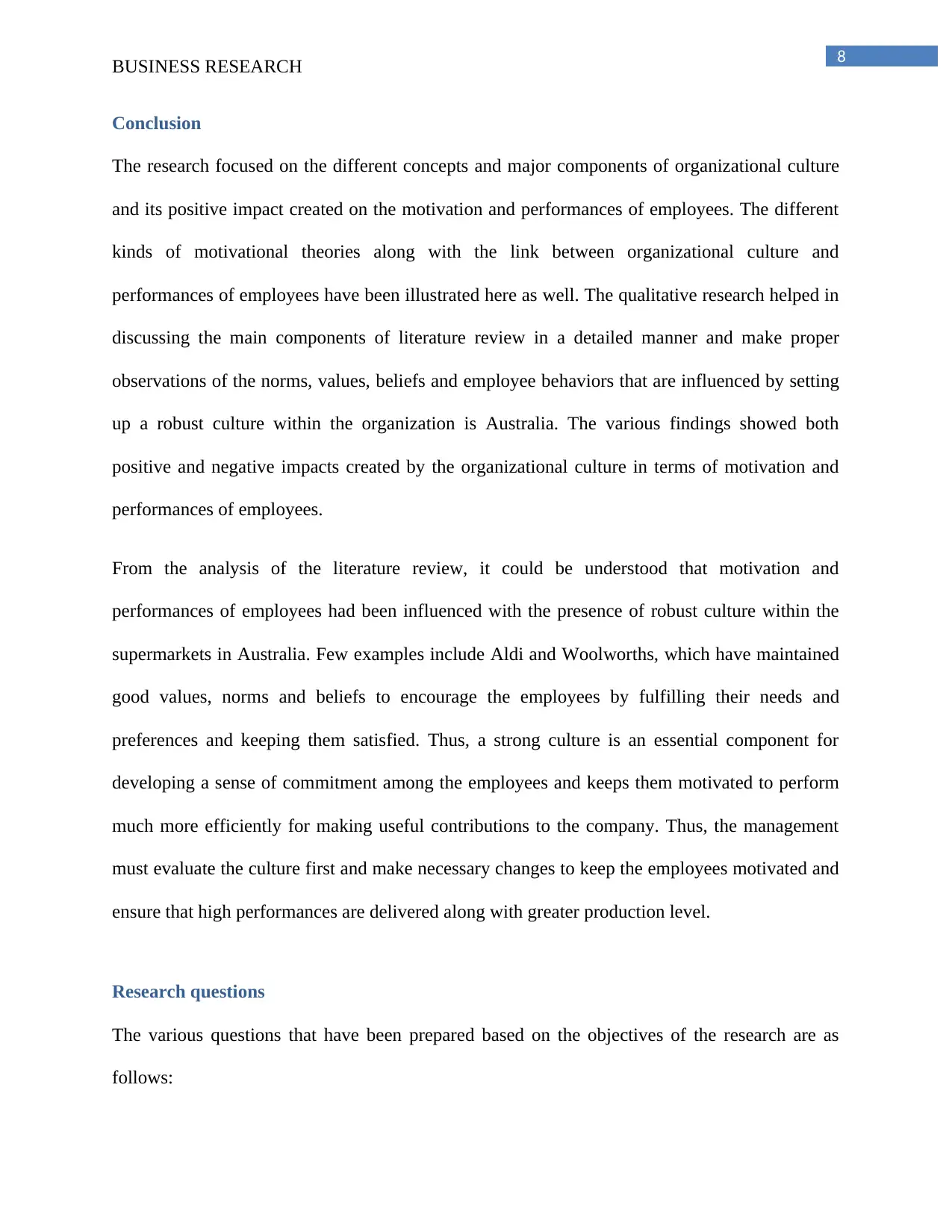
8
BUSINESS RESEARCH
Conclusion
The research focused on the different concepts and major components of organizational culture
and its positive impact created on the motivation and performances of employees. The different
kinds of motivational theories along with the link between organizational culture and
performances of employees have been illustrated here as well. The qualitative research helped in
discussing the main components of literature review in a detailed manner and make proper
observations of the norms, values, beliefs and employee behaviors that are influenced by setting
up a robust culture within the organization is Australia. The various findings showed both
positive and negative impacts created by the organizational culture in terms of motivation and
performances of employees.
From the analysis of the literature review, it could be understood that motivation and
performances of employees had been influenced with the presence of robust culture within the
supermarkets in Australia. Few examples include Aldi and Woolworths, which have maintained
good values, norms and beliefs to encourage the employees by fulfilling their needs and
preferences and keeping them satisfied. Thus, a strong culture is an essential component for
developing a sense of commitment among the employees and keeps them motivated to perform
much more efficiently for making useful contributions to the company. Thus, the management
must evaluate the culture first and make necessary changes to keep the employees motivated and
ensure that high performances are delivered along with greater production level.
Research questions
The various questions that have been prepared based on the objectives of the research are as
follows:
BUSINESS RESEARCH
Conclusion
The research focused on the different concepts and major components of organizational culture
and its positive impact created on the motivation and performances of employees. The different
kinds of motivational theories along with the link between organizational culture and
performances of employees have been illustrated here as well. The qualitative research helped in
discussing the main components of literature review in a detailed manner and make proper
observations of the norms, values, beliefs and employee behaviors that are influenced by setting
up a robust culture within the organization is Australia. The various findings showed both
positive and negative impacts created by the organizational culture in terms of motivation and
performances of employees.
From the analysis of the literature review, it could be understood that motivation and
performances of employees had been influenced with the presence of robust culture within the
supermarkets in Australia. Few examples include Aldi and Woolworths, which have maintained
good values, norms and beliefs to encourage the employees by fulfilling their needs and
preferences and keeping them satisfied. Thus, a strong culture is an essential component for
developing a sense of commitment among the employees and keeps them motivated to perform
much more efficiently for making useful contributions to the company. Thus, the management
must evaluate the culture first and make necessary changes to keep the employees motivated and
ensure that high performances are delivered along with greater production level.
Research questions
The various questions that have been prepared based on the objectives of the research are as
follows:
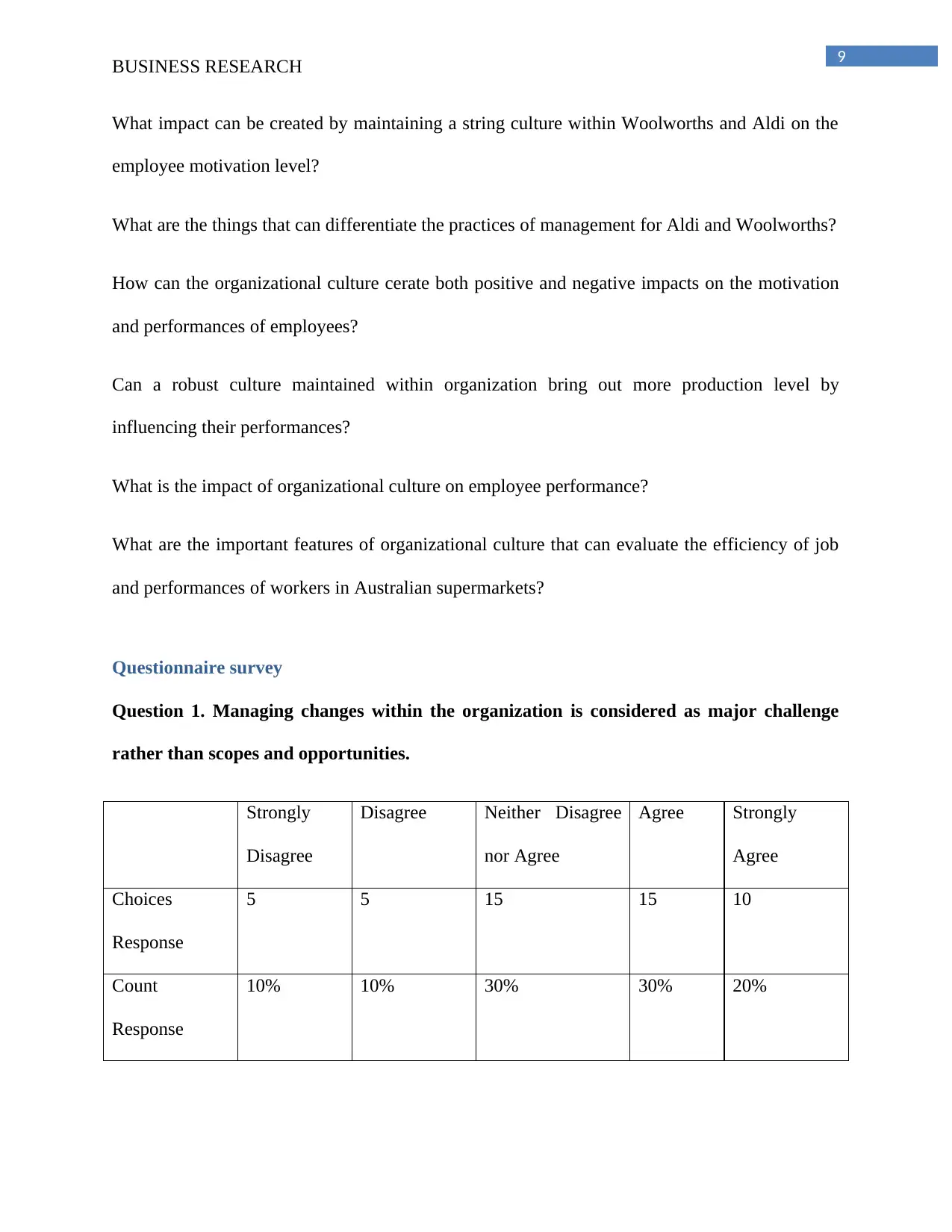
9
BUSINESS RESEARCH
What impact can be created by maintaining a string culture within Woolworths and Aldi on the
employee motivation level?
What are the things that can differentiate the practices of management for Aldi and Woolworths?
How can the organizational culture cerate both positive and negative impacts on the motivation
and performances of employees?
Can a robust culture maintained within organization bring out more production level by
influencing their performances?
What is the impact of organizational culture on employee performance?
What are the important features of organizational culture that can evaluate the efficiency of job
and performances of workers in Australian supermarkets?
Questionnaire survey
Question 1. Managing changes within the organization is considered as major challenge
rather than scopes and opportunities.
Strongly
Disagree
Disagree Neither Disagree
nor Agree
Agree Strongly
Agree
Choices
Response
5 5 15 15 10
Count
Response
10% 10% 30% 30% 20%
BUSINESS RESEARCH
What impact can be created by maintaining a string culture within Woolworths and Aldi on the
employee motivation level?
What are the things that can differentiate the practices of management for Aldi and Woolworths?
How can the organizational culture cerate both positive and negative impacts on the motivation
and performances of employees?
Can a robust culture maintained within organization bring out more production level by
influencing their performances?
What is the impact of organizational culture on employee performance?
What are the important features of organizational culture that can evaluate the efficiency of job
and performances of workers in Australian supermarkets?
Questionnaire survey
Question 1. Managing changes within the organization is considered as major challenge
rather than scopes and opportunities.
Strongly
Disagree
Disagree Neither Disagree
nor Agree
Agree Strongly
Agree
Choices
Response
5 5 15 15 10
Count
Response
10% 10% 30% 30% 20%
Secure Best Marks with AI Grader
Need help grading? Try our AI Grader for instant feedback on your assignments.
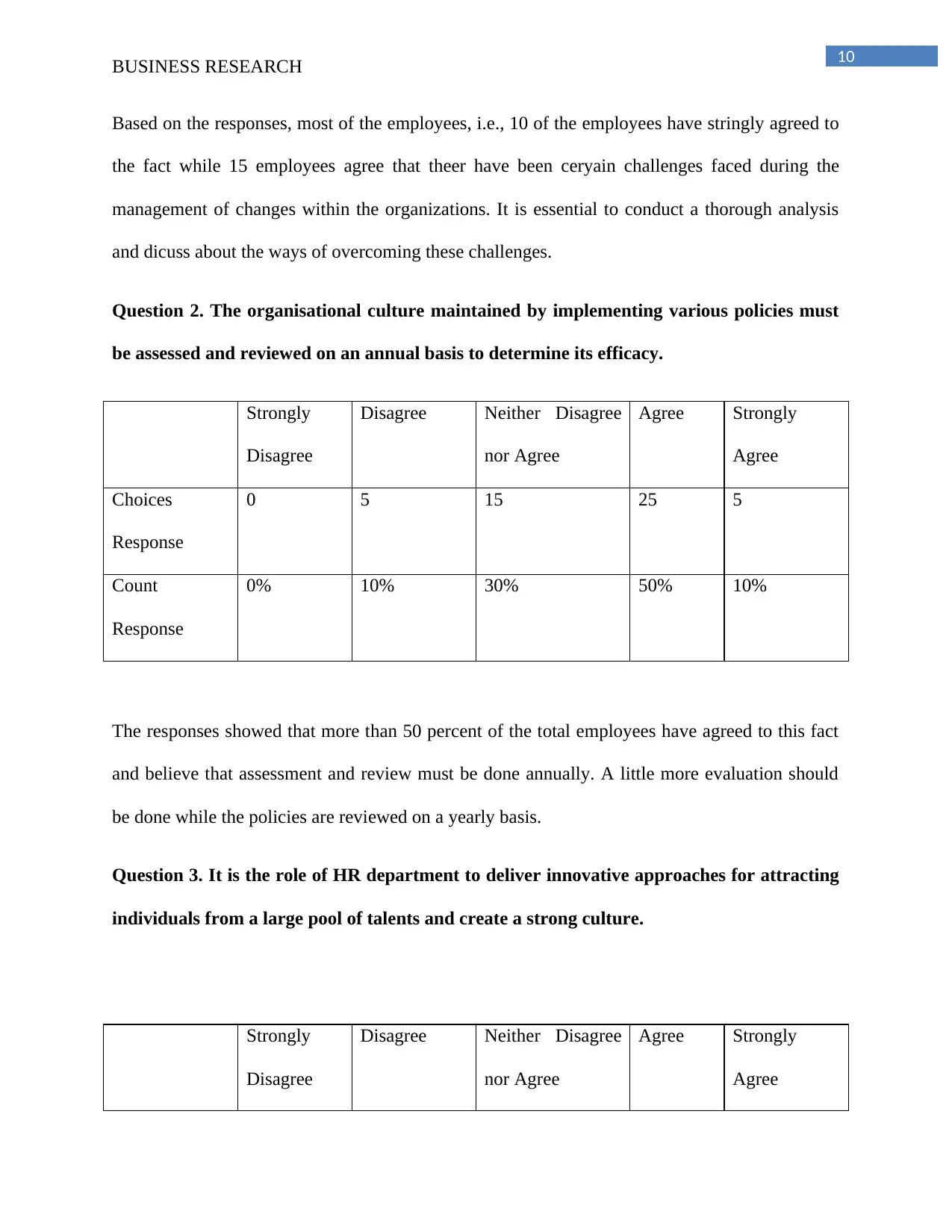
10
BUSINESS RESEARCH
Based on the responses, most of the employees, i.e., 10 of the employees have stringly agreed to
the fact while 15 employees agree that theer have been ceryain challenges faced during the
management of changes within the organizations. It is essential to conduct a thorough analysis
and dicuss about the ways of overcoming these challenges.
Question 2. The organisational culture maintained by implementing various policies must
be assessed and reviewed on an annual basis to determine its efficacy.
Strongly
Disagree
Disagree Neither Disagree
nor Agree
Agree Strongly
Agree
Choices
Response
0 5 15 25 5
Count
Response
0% 10% 30% 50% 10%
The responses showed that more than 50 percent of the total employees have agreed to this fact
and believe that assessment and review must be done annually. A little more evaluation should
be done while the policies are reviewed on a yearly basis.
Question 3. It is the role of HR department to deliver innovative approaches for attracting
individuals from a large pool of talents and create a strong culture.
Strongly
Disagree
Disagree Neither Disagree
nor Agree
Agree Strongly
Agree
BUSINESS RESEARCH
Based on the responses, most of the employees, i.e., 10 of the employees have stringly agreed to
the fact while 15 employees agree that theer have been ceryain challenges faced during the
management of changes within the organizations. It is essential to conduct a thorough analysis
and dicuss about the ways of overcoming these challenges.
Question 2. The organisational culture maintained by implementing various policies must
be assessed and reviewed on an annual basis to determine its efficacy.
Strongly
Disagree
Disagree Neither Disagree
nor Agree
Agree Strongly
Agree
Choices
Response
0 5 15 25 5
Count
Response
0% 10% 30% 50% 10%
The responses showed that more than 50 percent of the total employees have agreed to this fact
and believe that assessment and review must be done annually. A little more evaluation should
be done while the policies are reviewed on a yearly basis.
Question 3. It is the role of HR department to deliver innovative approaches for attracting
individuals from a large pool of talents and create a strong culture.
Strongly
Disagree
Disagree Neither Disagree
nor Agree
Agree Strongly
Agree
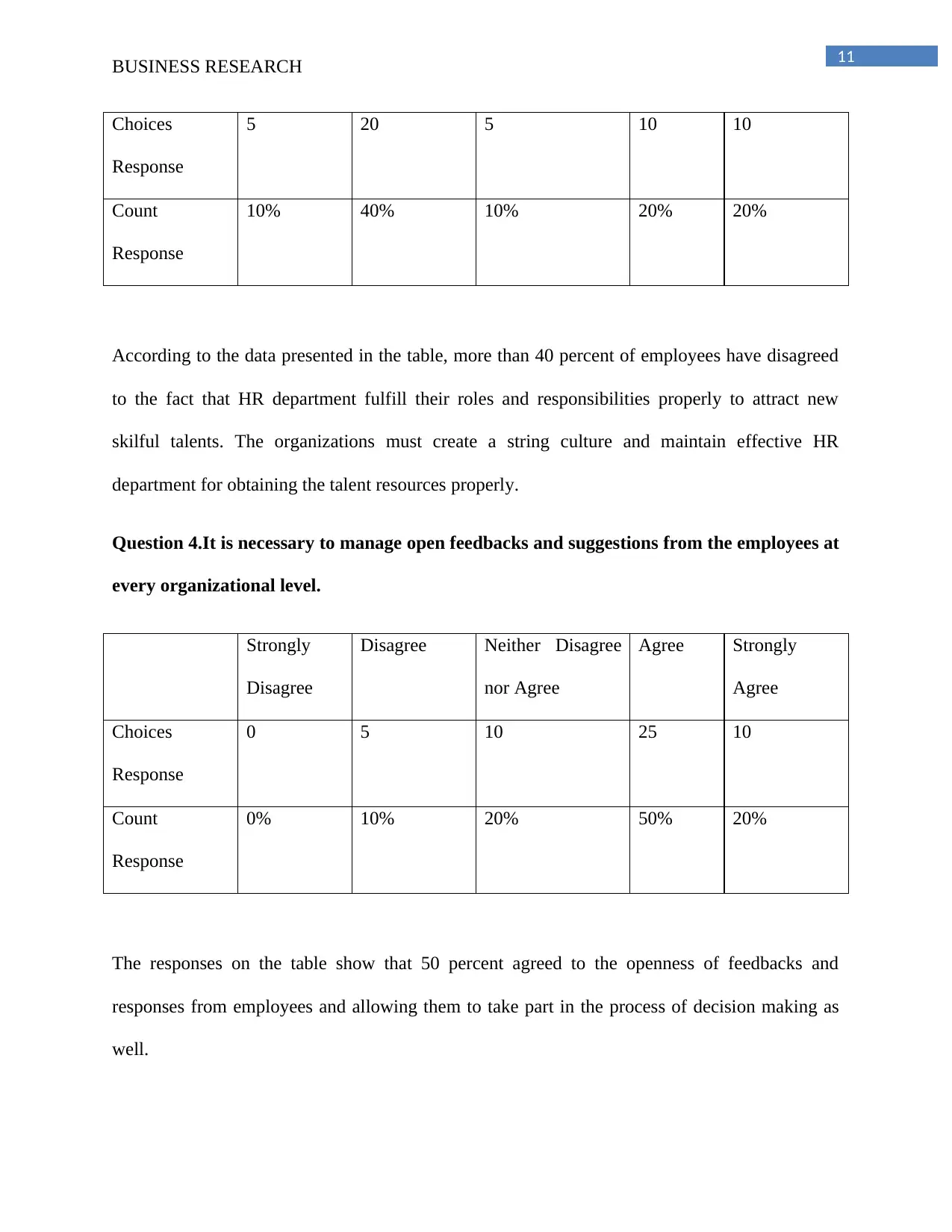
11
BUSINESS RESEARCH
Choices
Response
5 20 5 10 10
Count
Response
10% 40% 10% 20% 20%
According to the data presented in the table, more than 40 percent of employees have disagreed
to the fact that HR department fulfill their roles and responsibilities properly to attract new
skilful talents. The organizations must create a string culture and maintain effective HR
department for obtaining the talent resources properly.
Question 4.It is necessary to manage open feedbacks and suggestions from the employees at
every organizational level.
Strongly
Disagree
Disagree Neither Disagree
nor Agree
Agree Strongly
Agree
Choices
Response
0 5 10 25 10
Count
Response
0% 10% 20% 50% 20%
The responses on the table show that 50 percent agreed to the openness of feedbacks and
responses from employees and allowing them to take part in the process of decision making as
well.
BUSINESS RESEARCH
Choices
Response
5 20 5 10 10
Count
Response
10% 40% 10% 20% 20%
According to the data presented in the table, more than 40 percent of employees have disagreed
to the fact that HR department fulfill their roles and responsibilities properly to attract new
skilful talents. The organizations must create a string culture and maintain effective HR
department for obtaining the talent resources properly.
Question 4.It is necessary to manage open feedbacks and suggestions from the employees at
every organizational level.
Strongly
Disagree
Disagree Neither Disagree
nor Agree
Agree Strongly
Agree
Choices
Response
0 5 10 25 10
Count
Response
0% 10% 20% 50% 20%
The responses on the table show that 50 percent agreed to the openness of feedbacks and
responses from employees and allowing them to take part in the process of decision making as
well.
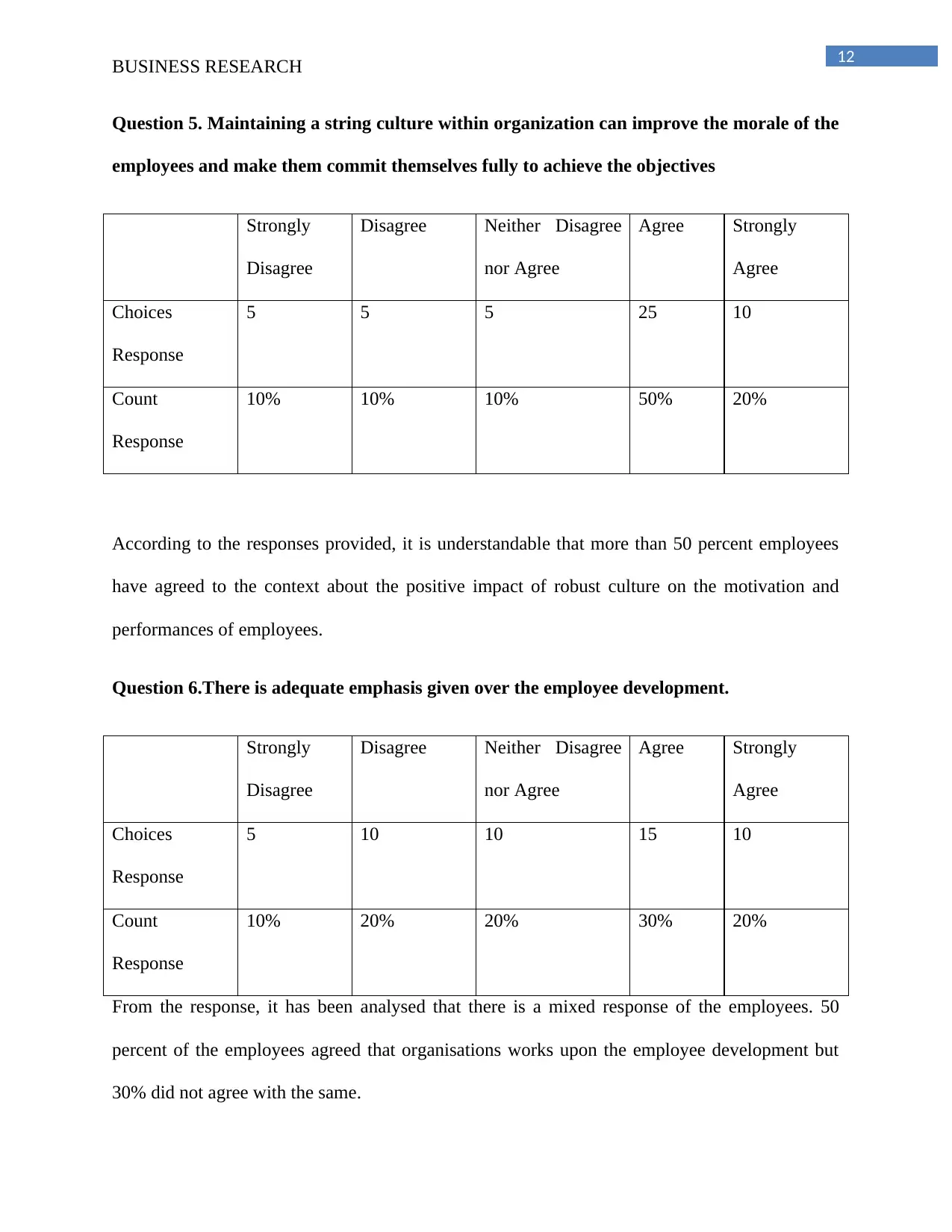
12
BUSINESS RESEARCH
Question 5. Maintaining a string culture within organization can improve the morale of the
employees and make them commit themselves fully to achieve the objectives
Strongly
Disagree
Disagree Neither Disagree
nor Agree
Agree Strongly
Agree
Choices
Response
5 5 5 25 10
Count
Response
10% 10% 10% 50% 20%
According to the responses provided, it is understandable that more than 50 percent employees
have agreed to the context about the positive impact of robust culture on the motivation and
performances of employees.
Question 6.There is adequate emphasis given over the employee development.
Strongly
Disagree
Disagree Neither Disagree
nor Agree
Agree Strongly
Agree
Choices
Response
5 10 10 15 10
Count
Response
10% 20% 20% 30% 20%
From the response, it has been analysed that there is a mixed response of the employees. 50
percent of the employees agreed that organisations works upon the employee development but
30% did not agree with the same.
BUSINESS RESEARCH
Question 5. Maintaining a string culture within organization can improve the morale of the
employees and make them commit themselves fully to achieve the objectives
Strongly
Disagree
Disagree Neither Disagree
nor Agree
Agree Strongly
Agree
Choices
Response
5 5 5 25 10
Count
Response
10% 10% 10% 50% 20%
According to the responses provided, it is understandable that more than 50 percent employees
have agreed to the context about the positive impact of robust culture on the motivation and
performances of employees.
Question 6.There is adequate emphasis given over the employee development.
Strongly
Disagree
Disagree Neither Disagree
nor Agree
Agree Strongly
Agree
Choices
Response
5 10 10 15 10
Count
Response
10% 20% 20% 30% 20%
From the response, it has been analysed that there is a mixed response of the employees. 50
percent of the employees agreed that organisations works upon the employee development but
30% did not agree with the same.
Paraphrase This Document
Need a fresh take? Get an instant paraphrase of this document with our AI Paraphraser
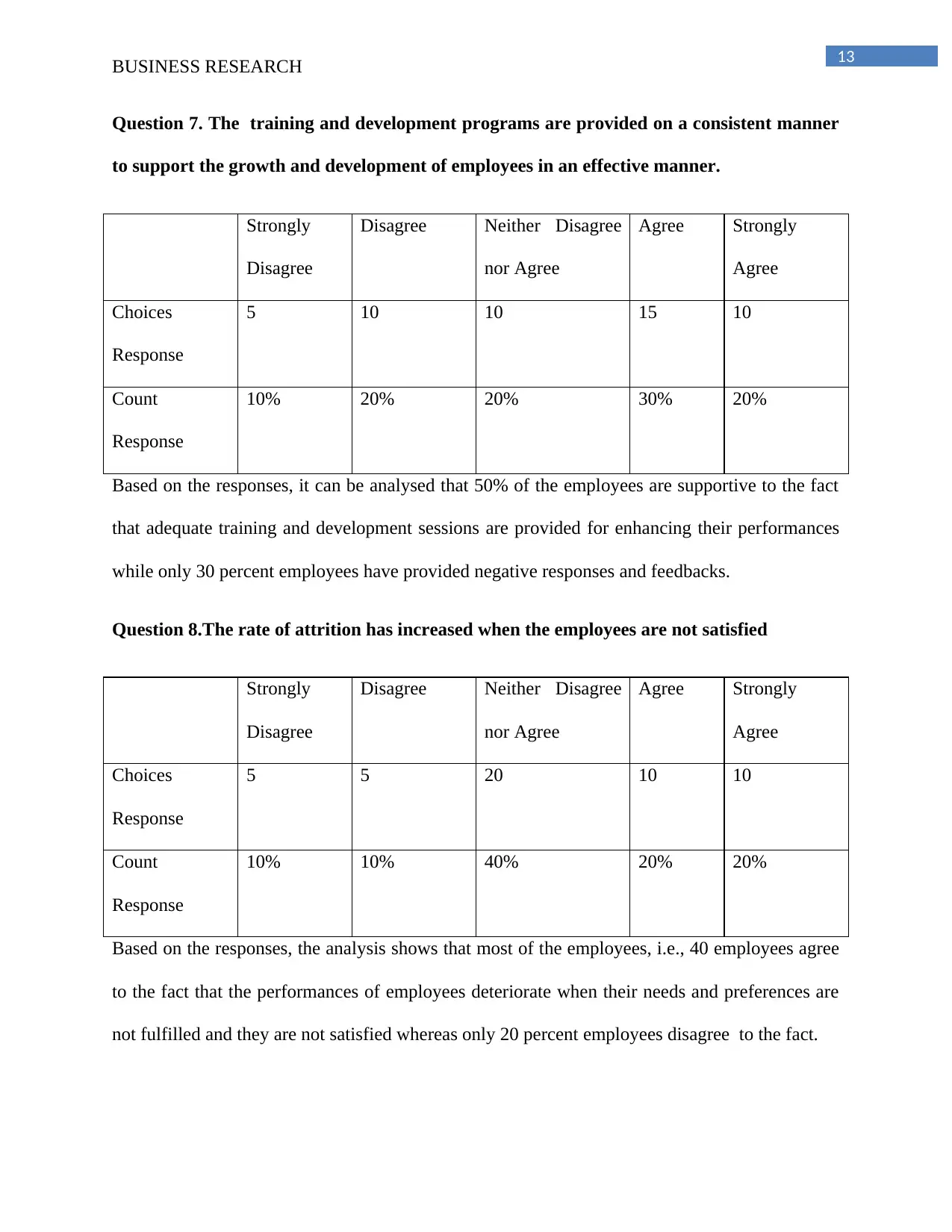
13
BUSINESS RESEARCH
Question 7. The training and development programs are provided on a consistent manner
to support the growth and development of employees in an effective manner.
Strongly
Disagree
Disagree Neither Disagree
nor Agree
Agree Strongly
Agree
Choices
Response
5 10 10 15 10
Count
Response
10% 20% 20% 30% 20%
Based on the responses, it can be analysed that 50% of the employees are supportive to the fact
that adequate training and development sessions are provided for enhancing their performances
while only 30 percent employees have provided negative responses and feedbacks.
Question 8.The rate of attrition has increased when the employees are not satisfied
Strongly
Disagree
Disagree Neither Disagree
nor Agree
Agree Strongly
Agree
Choices
Response
5 5 20 10 10
Count
Response
10% 10% 40% 20% 20%
Based on the responses, the analysis shows that most of the employees, i.e., 40 employees agree
to the fact that the performances of employees deteriorate when their needs and preferences are
not fulfilled and they are not satisfied whereas only 20 percent employees disagree to the fact.
BUSINESS RESEARCH
Question 7. The training and development programs are provided on a consistent manner
to support the growth and development of employees in an effective manner.
Strongly
Disagree
Disagree Neither Disagree
nor Agree
Agree Strongly
Agree
Choices
Response
5 10 10 15 10
Count
Response
10% 20% 20% 30% 20%
Based on the responses, it can be analysed that 50% of the employees are supportive to the fact
that adequate training and development sessions are provided for enhancing their performances
while only 30 percent employees have provided negative responses and feedbacks.
Question 8.The rate of attrition has increased when the employees are not satisfied
Strongly
Disagree
Disagree Neither Disagree
nor Agree
Agree Strongly
Agree
Choices
Response
5 5 20 10 10
Count
Response
10% 10% 40% 20% 20%
Based on the responses, the analysis shows that most of the employees, i.e., 40 employees agree
to the fact that the performances of employees deteriorate when their needs and preferences are
not fulfilled and they are not satisfied whereas only 20 percent employees disagree to the fact.
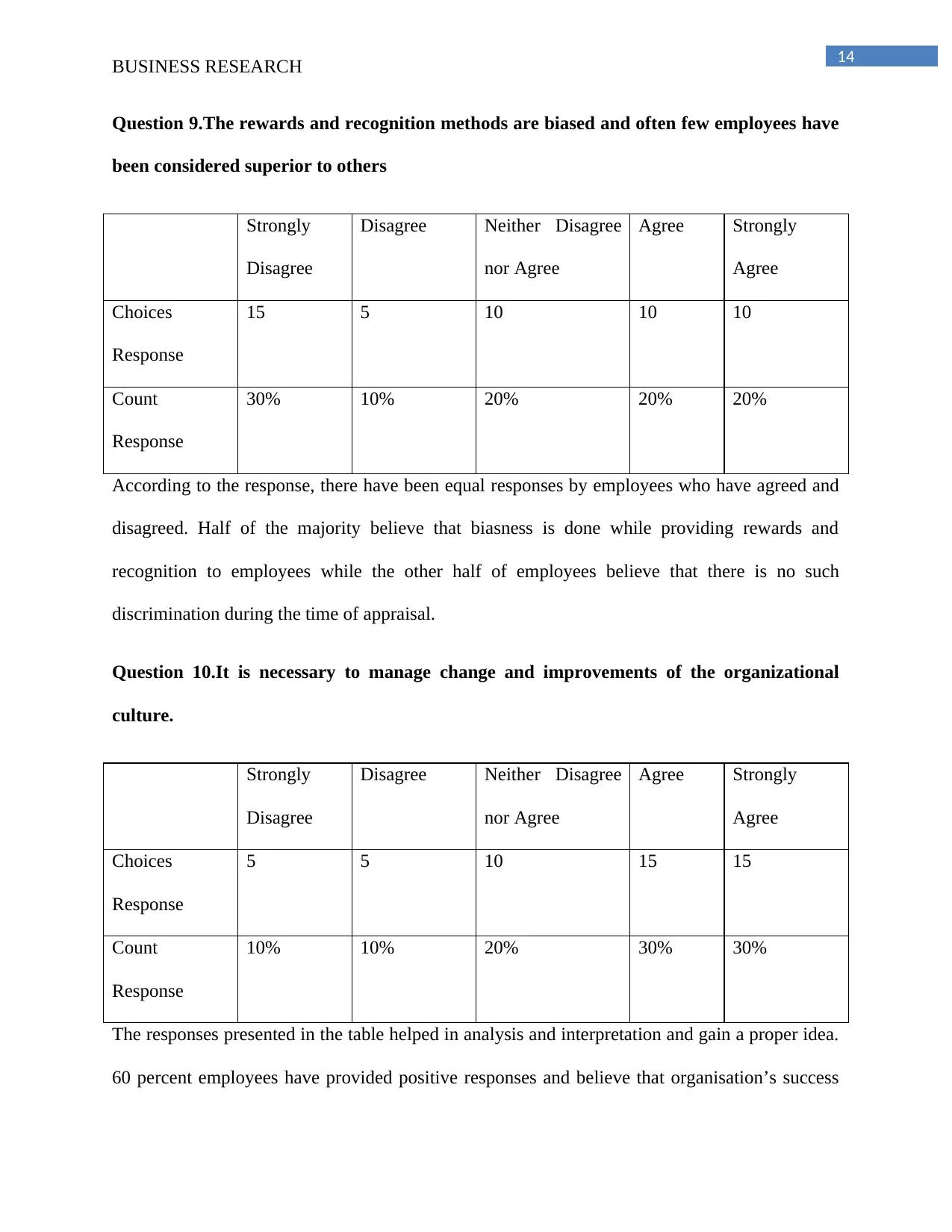
14
BUSINESS RESEARCH
Question 9.The rewards and recognition methods are biased and often few employees have
been considered superior to others
Strongly
Disagree
Disagree Neither Disagree
nor Agree
Agree Strongly
Agree
Choices
Response
15 5 10 10 10
Count
Response
30% 10% 20% 20% 20%
According to the response, there have been equal responses by employees who have agreed and
disagreed. Half of the majority believe that biasness is done while providing rewards and
recognition to employees while the other half of employees believe that there is no such
discrimination during the time of appraisal.
Question 10.It is necessary to manage change and improvements of the organizational
culture.
Strongly
Disagree
Disagree Neither Disagree
nor Agree
Agree Strongly
Agree
Choices
Response
5 5 10 15 15
Count
Response
10% 10% 20% 30% 30%
The responses presented in the table helped in analysis and interpretation and gain a proper idea.
60 percent employees have provided positive responses and believe that organisation’s success
BUSINESS RESEARCH
Question 9.The rewards and recognition methods are biased and often few employees have
been considered superior to others
Strongly
Disagree
Disagree Neither Disagree
nor Agree
Agree Strongly
Agree
Choices
Response
15 5 10 10 10
Count
Response
30% 10% 20% 20% 20%
According to the response, there have been equal responses by employees who have agreed and
disagreed. Half of the majority believe that biasness is done while providing rewards and
recognition to employees while the other half of employees believe that there is no such
discrimination during the time of appraisal.
Question 10.It is necessary to manage change and improvements of the organizational
culture.
Strongly
Disagree
Disagree Neither Disagree
nor Agree
Agree Strongly
Agree
Choices
Response
5 5 10 15 15
Count
Response
10% 10% 20% 30% 30%
The responses presented in the table helped in analysis and interpretation and gain a proper idea.
60 percent employees have provided positive responses and believe that organisation’s success
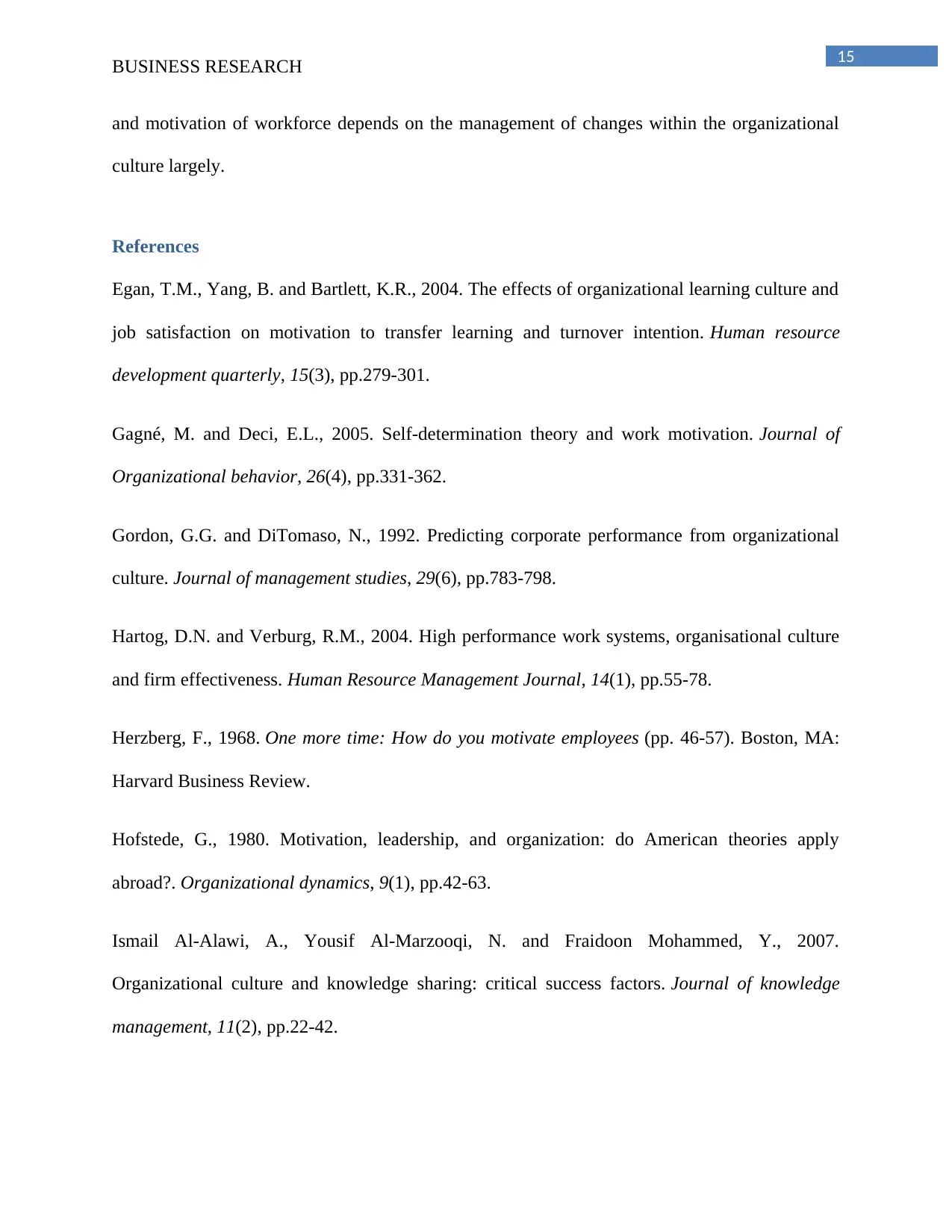
15
BUSINESS RESEARCH
and motivation of workforce depends on the management of changes within the organizational
culture largely.
References
Egan, T.M., Yang, B. and Bartlett, K.R., 2004. The effects of organizational learning culture and
job satisfaction on motivation to transfer learning and turnover intention. Human resource
development quarterly, 15(3), pp.279-301.
Gagné, M. and Deci, E.L., 2005. Self‐determination theory and work motivation. Journal of
Organizational behavior, 26(4), pp.331-362.
Gordon, G.G. and DiTomaso, N., 1992. Predicting corporate performance from organizational
culture. Journal of management studies, 29(6), pp.783-798.
Hartog, D.N. and Verburg, R.M., 2004. High performance work systems, organisational culture
and firm effectiveness. Human Resource Management Journal, 14(1), pp.55-78.
Herzberg, F., 1968. One more time: How do you motivate employees (pp. 46-57). Boston, MA:
Harvard Business Review.
Hofstede, G., 1980. Motivation, leadership, and organization: do American theories apply
abroad?. Organizational dynamics, 9(1), pp.42-63.
Ismail Al-Alawi, A., Yousif Al-Marzooqi, N. and Fraidoon Mohammed, Y., 2007.
Organizational culture and knowledge sharing: critical success factors. Journal of knowledge
management, 11(2), pp.22-42.
BUSINESS RESEARCH
and motivation of workforce depends on the management of changes within the organizational
culture largely.
References
Egan, T.M., Yang, B. and Bartlett, K.R., 2004. The effects of organizational learning culture and
job satisfaction on motivation to transfer learning and turnover intention. Human resource
development quarterly, 15(3), pp.279-301.
Gagné, M. and Deci, E.L., 2005. Self‐determination theory and work motivation. Journal of
Organizational behavior, 26(4), pp.331-362.
Gordon, G.G. and DiTomaso, N., 1992. Predicting corporate performance from organizational
culture. Journal of management studies, 29(6), pp.783-798.
Hartog, D.N. and Verburg, R.M., 2004. High performance work systems, organisational culture
and firm effectiveness. Human Resource Management Journal, 14(1), pp.55-78.
Herzberg, F., 1968. One more time: How do you motivate employees (pp. 46-57). Boston, MA:
Harvard Business Review.
Hofstede, G., 1980. Motivation, leadership, and organization: do American theories apply
abroad?. Organizational dynamics, 9(1), pp.42-63.
Ismail Al-Alawi, A., Yousif Al-Marzooqi, N. and Fraidoon Mohammed, Y., 2007.
Organizational culture and knowledge sharing: critical success factors. Journal of knowledge
management, 11(2), pp.22-42.
Secure Best Marks with AI Grader
Need help grading? Try our AI Grader for instant feedback on your assignments.
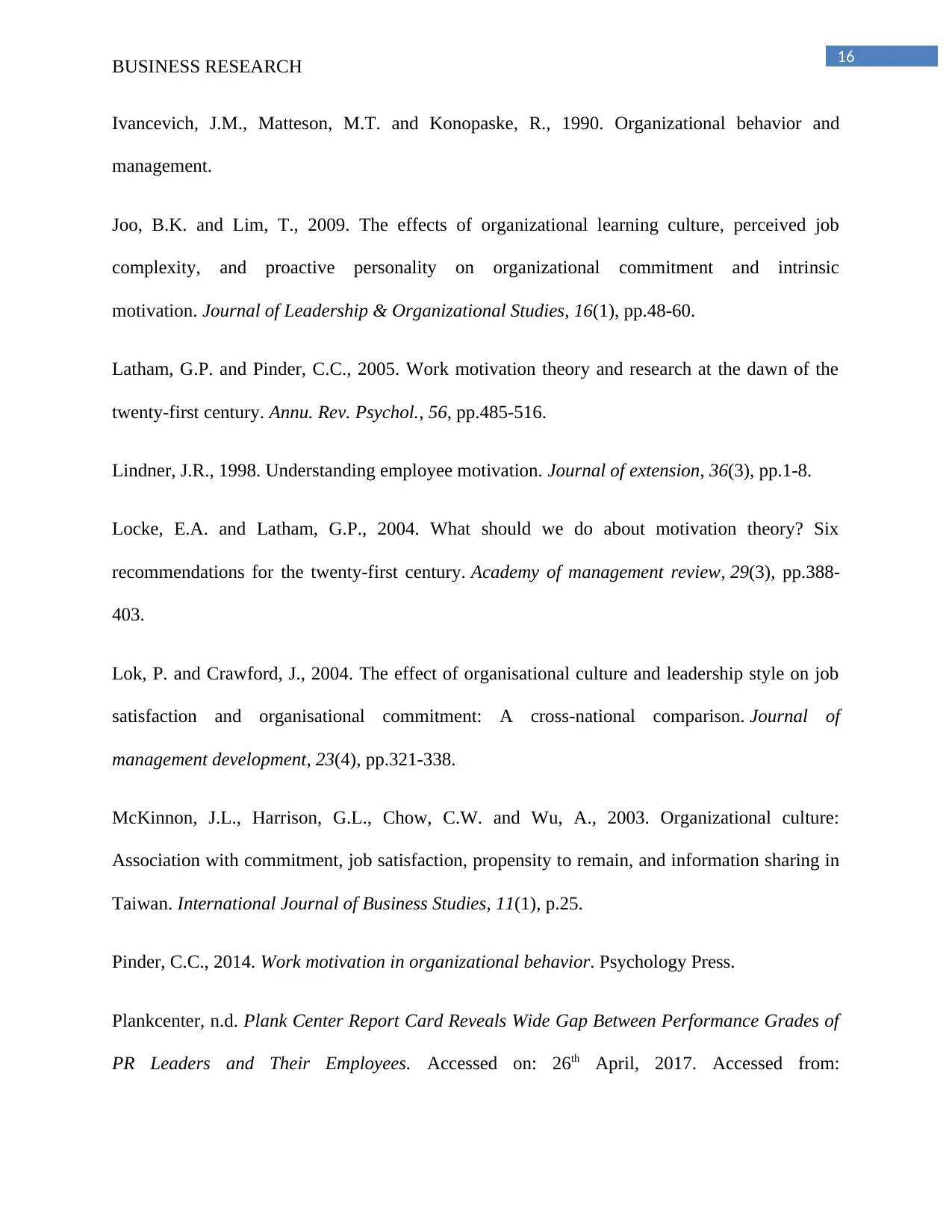
16
BUSINESS RESEARCH
Ivancevich, J.M., Matteson, M.T. and Konopaske, R., 1990. Organizational behavior and
management.
Joo, B.K. and Lim, T., 2009. The effects of organizational learning culture, perceived job
complexity, and proactive personality on organizational commitment and intrinsic
motivation. Journal of Leadership & Organizational Studies, 16(1), pp.48-60.
Latham, G.P. and Pinder, C.C., 2005. Work motivation theory and research at the dawn of the
twenty-first century. Annu. Rev. Psychol., 56, pp.485-516.
Lindner, J.R., 1998. Understanding employee motivation. Journal of extension, 36(3), pp.1-8.
Locke, E.A. and Latham, G.P., 2004. What should we do about motivation theory? Six
recommendations for the twenty-first century. Academy of management review, 29(3), pp.388-
403.
Lok, P. and Crawford, J., 2004. The effect of organisational culture and leadership style on job
satisfaction and organisational commitment: A cross-national comparison. Journal of
management development, 23(4), pp.321-338.
McKinnon, J.L., Harrison, G.L., Chow, C.W. and Wu, A., 2003. Organizational culture:
Association with commitment, job satisfaction, propensity to remain, and information sharing in
Taiwan. International Journal of Business Studies, 11(1), p.25.
Pinder, C.C., 2014. Work motivation in organizational behavior. Psychology Press.
Plankcenter, n.d. Plank Center Report Card Reveals Wide Gap Between Performance Grades of
PR Leaders and Their Employees. Accessed on: 26th April, 2017. Accessed from:
BUSINESS RESEARCH
Ivancevich, J.M., Matteson, M.T. and Konopaske, R., 1990. Organizational behavior and
management.
Joo, B.K. and Lim, T., 2009. The effects of organizational learning culture, perceived job
complexity, and proactive personality on organizational commitment and intrinsic
motivation. Journal of Leadership & Organizational Studies, 16(1), pp.48-60.
Latham, G.P. and Pinder, C.C., 2005. Work motivation theory and research at the dawn of the
twenty-first century. Annu. Rev. Psychol., 56, pp.485-516.
Lindner, J.R., 1998. Understanding employee motivation. Journal of extension, 36(3), pp.1-8.
Locke, E.A. and Latham, G.P., 2004. What should we do about motivation theory? Six
recommendations for the twenty-first century. Academy of management review, 29(3), pp.388-
403.
Lok, P. and Crawford, J., 2004. The effect of organisational culture and leadership style on job
satisfaction and organisational commitment: A cross-national comparison. Journal of
management development, 23(4), pp.321-338.
McKinnon, J.L., Harrison, G.L., Chow, C.W. and Wu, A., 2003. Organizational culture:
Association with commitment, job satisfaction, propensity to remain, and information sharing in
Taiwan. International Journal of Business Studies, 11(1), p.25.
Pinder, C.C., 2014. Work motivation in organizational behavior. Psychology Press.
Plankcenter, n.d. Plank Center Report Card Reveals Wide Gap Between Performance Grades of
PR Leaders and Their Employees. Accessed on: 26th April, 2017. Accessed from:
1 out of 17
Related Documents
Your All-in-One AI-Powered Toolkit for Academic Success.
+13062052269
info@desklib.com
Available 24*7 on WhatsApp / Email
![[object Object]](/_next/static/media/star-bottom.7253800d.svg)
Unlock your academic potential
© 2024 | Zucol Services PVT LTD | All rights reserved.





